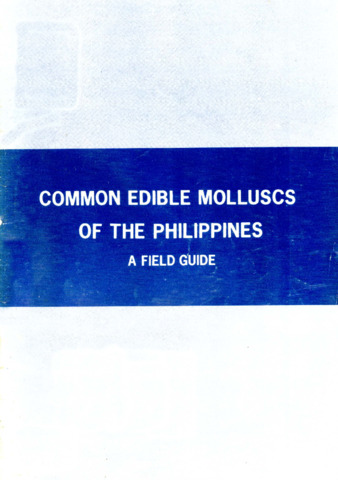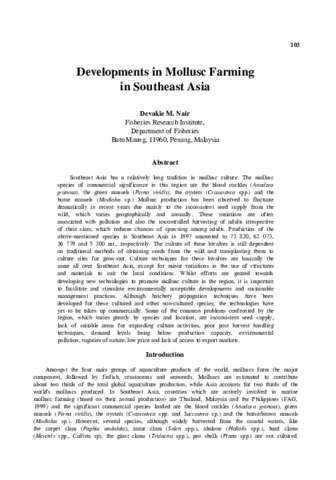Common edible molluscs of the Philippines: A field guide
- Global styles
- MLA
- Vancouver
- Elsevier - Harvard
- APA
- Help

Date
1981Author
Page views
11,647ASFA keyword
Taxonomic term
Anadara granosa 
Tegillarca granosa
Arca antiquata
Anadara antiquata
Anadara
Modiolus metcalfei
Modiolus modulaides
Perna viridis
Brachidontes
Amusium pleuronectes
Crassostrea iredalei
Magallana bilineata
Saccostrea
Placuna placenta
Cardium subrugosum
Vasticardium subrugosum
Soletellina
Isognomon
Mactra mera
Mactra grandis
Mactra maculata
Pharella acutidens
Donax
Geloina
Paphia exarata
Circe
Teredo
Trochus niloticus
Rochia nilotica
Turbo chrysostomus
Angaria delphinus
Cypraea moneta
Monetaria moneta
Cypraea tigris
Telescopium telescopium
Potamides
Lambis lambis
Strombus aurisdianae
Euprotomus aurisdianae
Strombus bulla
Euprotomus bulla
Strombus lentiginosus
Lentigo lentiginosus
Strombus luhuanus
Conomurex luhuanus
Strombus
Turritella terebra
Conus leopardus
Conus omaria
Conus striatus
Conus
Ocenebra
Oliva annulata
Cymbiola vespertilio
Nautilus pompilius
Pectinidae
Arcidae

Tegillarca granosa

Arca antiquata

Anadara antiquata

Anadara

Modiolus metcalfei

Modiolus modulaides

Perna viridis

Brachidontes

Amusium pleuronectes

Crassostrea iredalei

Magallana bilineata

Saccostrea

Placuna placenta

Cardium subrugosum

Vasticardium subrugosum

Soletellina

Isognomon

Mactra mera

Mactra grandis

Mactra maculata

Pharella acutidens

Donax

Geloina

Paphia exarata

Circe

Teredo

Trochus niloticus

Rochia nilotica

Turbo chrysostomus

Angaria delphinus

Cypraea moneta

Monetaria moneta

Cypraea tigris

Telescopium telescopium

Potamides

Lambis lambis

Strombus aurisdianae

Euprotomus aurisdianae

Strombus bulla

Euprotomus bulla

Strombus lentiginosus

Lentigo lentiginosus

Strombus luhuanus

Conomurex luhuanus

Strombus

Turritella terebra

Conus leopardus

Conus omaria

Conus striatus

Conus

Ocenebra

Oliva annulata

Cymbiola vespertilio

Nautilus pompilius

Pectinidae

Arcidae

Geographic names
Metadata
Show full item recordShare
Subjects
Edible mollusksDescription
The Molluscs comprise the largest phylum of marine invertebrates, with over 80,000 species described (Barnes, 1974). They are soft-bodied animals, which, in most cases, secrete a protective outer "shell." Two major classes of molluscs, the Bivalvia and Gastropoda (or univalves), are covered in this work, as they contain most of the edible and economically important species. Class Cephalopoda is represented by the Chambered Nautilus.
Because of the huge number of molluscan species inhabiting Philippine waters (over 20,000 by some estimates) this study has been limited to the most common edible ones existing on and around the island of Panay in the Western Visayas region. This region was selected as representative because some species unique to the Philippine co-exist here with many that are commonly found throughout the Indo-Pacific (Abbott, 1979) and because Panay is located in the geographic center of the Philippines. The species described here are primarily marine, with a few brackish and fresh water varieties included. Marine species predominate in local diets, partly as a result of the increased use of chemical pesticides and fertilizers in recent years in ricelands and fishponds, which were once prime habitats for many edible fresh and brackish water species.
As our world becomes more polluted and populous, edible molluscs, which serve as a major source of protein for many millions of people (Abbott, 1976), are becoming a primary focus of those involved in mariculture activities. This field guide is intended not only for them, but also for students, shell collectors, travelers, and anyone interested in molluscs and how they benefit the people of the Philippines.
This work consists of a series of identification sheets which contain the following basic information:
1. Pen and ink drawings and photographs of each species
2. Scientific classification
3. Common names in English and Philippine dialects
4. Brief description of shell color and form
5. Ecological and habitat description
6. Collection and/or culture techniques
7. Market price
8. Preparation as food
Supplementary or unusual information about each species is also included where appropriate.
Suggested Citation
Edwards, R. L. (1981). Common edible molluscs of the Philippines: A field guide. Aquaculture Department, Southeast Asian Fisheries Development Center.
Type
BookFormat
55 pages : illustrations ; 22 cm.
Collections
- Handbooks [6]
Related items
Showing items related by title, author, creator and subject.
-
Coastal aquaculture in Thailand
Sahavacharin, Songchai (Aquaculture Department, Southeast Asian Fisheries Development Center, 1995)Coastal aquaculture in Thailand has expanded rapidly in both area and production in the last decade. The important cultured species are the shrimps (Penaeus monodon and P. merguiensis), sea bass Lates calcarifer, groupers ... -
Developments in mollusc farming in Southeast Asia
Nair, Devakie M. (Aquaculture Department, Southeast Asian Fisheries Development Center, 2001)Southeast Asia has a relatively long tradition in mollusc culture. The mollusc species of commercial significance in this region are the blood cockles (Anadara granosa), the green mussels (Perna viridis), the oysters ... -
Aquaculture development in Thailand
Sirikul, Boonsong; Luanprida, Somsak; Chaiyakam, Kanit; Sriprasert, Revadee (Aquaculture Department, Southeast Asian Fisheries Development Center, 1988)Aquaculture practised in Thailand is in the form of pond culture and cage culture in freshwater, brackishwater and coastal areas. The main species cultured include freshwater prawns, brackishwater shrimp, cockles, mussels, ...






